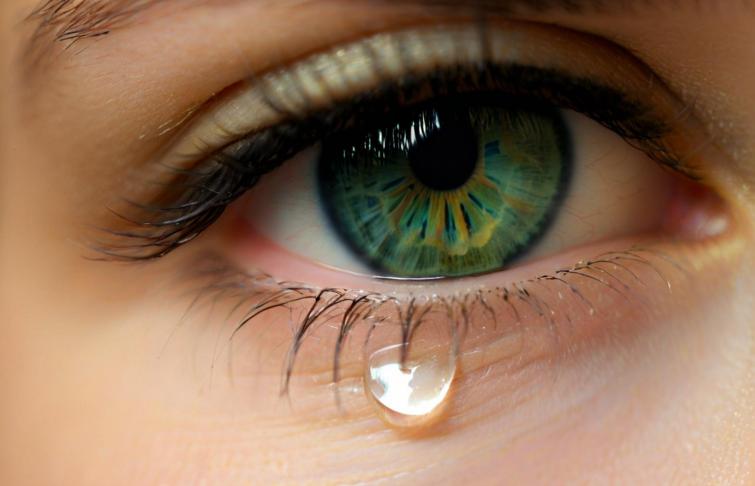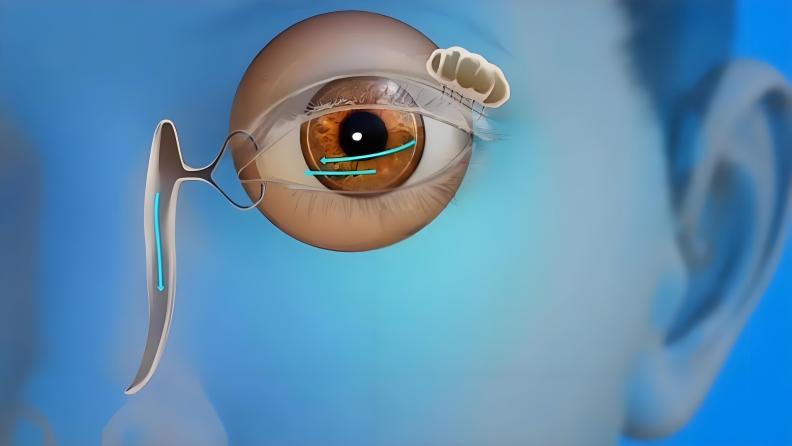Tears all day, be careful of the strange lacrimal duct disease.

Aunt Zhang, 55, has always felt that her eyes love tears in the past two years, especially in the wind. At first, she thought she was old and her eyes became sensitive, so she didn’t care too much. But as time goes by, there are more and more tears, even indoors, and the corners of my eyes are often wet. What bothers her even more is that there are secretions in the corners of her eyes from time to time. When she wakes up in the morning, her eyelids are often covered with "gum". She went to the drugstore to buy eye drops to use, but the symptoms were only temporarily relieved and recurred after a while. Later, accompanied by her family, she went to tongji hospital for ophthalmology treatment.

After detailed examination, Dr. Li Houshuo, an expert on lacrimal duct diseases in tongji hospital, found that Aunt Zhang had slight redness and swelling around the lacrimal punctum under her right eye, and purulent secretions flowed out when pressing the lacrimal sac. Further examination of lacrimal duct irrigation found that normal saline could not flow into the nasal cavity smoothly, but flowed back from the lacrimal punctum. Combined with symptoms and examination results, she was diagnosed as suffering from chronic dacryocystitis, the root cause of which was lacrimal duct obstruction.
Tears have not been alleviated, and it may not be a small problem!
01
Understanding lacrimal passage: the drainage system of tears
The lacrimal passage is the passage through which tears are discharged from the ocular surface to the nasal cavity, mainly including lacrimal punctum, lacrimal canaliculus, lacrimal sac and nasolacrimal duct. Under normal circumstances, the tears secreted by the lacrimal gland can moisten the surface of the eyeball and drain into the nasal cavity through the lacrimal passage. However, when the lacrimal passage is blocked or narrowed, tears can’t be discharged smoothly, and they will overflow the eyes, forming a phenomenon of "tears", which is called "tears overflow" in medicine.

02
Lacrimal obstruction and dacryocystitis: an invisible troublemaker
Aunt Zhang’s condition belongs to nasolacrimal duct obstruction, which is one of the most common lacrimal duct diseases in middle-aged and elderly people. Because nasolacrimal duct is stimulated by chronic inflammation for a long time, mucosa hyperplasia, stenosis and even complete obstruction lead to tears staying in lacrimal sac, forming chronic dacryocystitis. Over time, the lacrimal sac becomes a "pond for storing bacteria". Patients not only shed tears, but also are prone to increase, redness and swelling of canthus secretions, and even repeated acute attacks, characterized by redness and tenderness in the lacrimal sac area, accompanied by a large number of purulent secretions.
03
How to judge whether you have lacrimal duct disease?
If you often have the following symptoms, you should be alert to the possibility of lacrimal duct disease:
Often shed tears involuntarily, especially in windward or cold weather;
The secretion of canthus increases, especially when there is "eye excrement" sticking to the eyelid margin in the morning;
The skin around the corner of the eye is wet for a long time, and even redness and eczema appear;
When the eye corner (lacrimal sac area) is lightly pressed, secretions overflow from the eye corner (lacrimal punctum);
Repeated redness and pain in the corners of the eyes, and even abscess formation.
Note: Long-term untreated dacryocystitis may cause corneal ulcer and even blindness!
04
How to treat lacrimal duct diseases?
The treatment of lacrimal duct obstruction mainly depends on the cause and severity, and the common methods include:
Lacrimal canal irrigation: those with mild obstruction can try to flush the lacrimal canal with normal saline, which is helpful to dredge some slightly narrow channels.
Probe into lacrimal passage: It is suitable for some patients with early lacrimal passage obstruction, and the narrow lacrimal passage is dredged by probe, but it is easy to recur.
Lacrimal duct laser/lacrimal duct catheterization: It is suitable for patients with moderate stenosis. The narrow segment is dilated by laser or balloon, and a lacrimal duct is implanted to improve the patency of lacrimal duct, but the recurrence rate is also high.
Dacryocystorhinostomy (DCR): For patients with complete obstruction of nasolacrimal duct, it is necessary to establish a new drainage channel with high success rate, which is the gold standard for the treatment of chronic dacryocystitis at present.
05
Prevent lacrimal duct diseases and protect eye health.
Avoid long-term exposure to irritants such as dust and smoke, and reduce the risk of lacrimal duct inflammation;
Timely treatment of nasal diseases such as rhinitis and sinusitis, so as not to affect the patency of lacrimal passage;
When the eyes have unexplained tears, increased secretions and other symptoms, seek medical advice as soon as possible, and don’t take medicine by yourself, so as not to delay the best treatment opportunity.
After Aunt Zhang was diagnosed, tongji hospital Ophthalmologist Li Houshuo and Dr. Zhang Juan performed dacryocystorhinostomy for her. After the operation, the increase of tears and secretions completely disappeared, and finally bid farewell to the "tearful" days.
Tears in the eyes are not necessarily just "more tears", it is likely that lacrimal duct diseases are at work. If you or your family have a similar situation, it is recommended to seek medical advice in time, early diagnosis and early treatment, so that your eyes can be clear and bright again!
Text | Sun Yunqi
Typesetting | Shao Yuting Review | Li Houshuo
Brief introduction of the author

Deputy Chief Physician Li Houshuo
Good at: completing thousands of eye operations, specializing in the diagnosis and treatment of complex cataracts, orbital and lacrimal diseases, eye plastic surgery and cosmetic surgery (eyelid repair and reconstruction, double eyelids, pouch removal, ptosis, trichiasis, ectropion, etc.).

Sun Yunqi Resident Physician
Good at: prevention and control of refraction and myopia, research on the progress of artificial retina products.
-Introduction of tongji hospital Ophthalmology Affiliated to Tongji University-
Swipe up to read
Introduction of tongji hospital Ophthalmology (tongji hospital Ophthalmology Affiliated to Tongji University)
In 2025, the tongji hospital Ophthalmology Team affiliated to Tongji University consists of 18 clinicians (led by Professor Bi Yanlong), 10 experts in basic ophthalmology research (led by Professor Xu Guotong (chief researcher of tongji hospital (Ophthalmology)), 3 technicians (3 people), 13 nurses (13 people), 8 trained doctors (8 people) and academic doctoral students.
Relying on the resource advantages of tongji hospital affiliated to Tongji University, Institute of Ophthalmology of Tongji University School of Medicine, and Department of Ophthalmology of Cologne University (an international cooperation and co-construction unit), the team took the domestic leading anterior and posterior joint surgery based on the "holistic view of eye diseases" as the clinical technical barrier, based in Shanghai, and radiated and benefited patients with refractory eye diseases nationwide. The team members won the honorary titles of "Top Ten Medical Contribution Experts", "Bethune Good Doctor" and "Tongji Famous Doctor". Deeply cultivate the research and development and transformation of medical devices, promote the transformation of new medical devices by promoting the tripartite cooperation between doctors, schools and enterprises, and empower new clinical technologies. Many achievements won the technical innovation gold and silver awards of Shanghai Excellent Invention Selection Competition and the first and second prizes of Shanghai Starlight Project; Establish a network of stem cell banks and key technology platforms, and become a national stem cell technology training base and a platform for stem cell information release and exchange; Long-term commitment to the scientific research of eye diseases facing all ages and life cycle, forming a basic-clinical research system for eye disease prevention and treatment, especially in the research direction of diabetic retinopathy and cataract, which has achieved international attention and won the Science and Technology Progress Award of the Ministry of Education and the Shanghai Science and Technology Award for many times; Adhering to the initial intention of educating people, we have continuously developed and improved the ophthalmic personnel training system that meets the requirements of the new era. We have been approved for national first-class undergraduate courses, several key courses in Shanghai universities and first-class undergraduate courses, and guided college students to win the second prize of the National College Students Innovation Forum and Experimental Design Competition, the gold prize of the China International internet plus College Students Innovation and Entrepreneurship Competition, and the bronze prize of the Shanghai Division.Train more than ten people, including Shanghai Youth May 4th Medal winners and outstanding graduates in Shanghai; Facing the national strategy and fulfilling social responsibilities, Tongji University’s volunteer service system of "Help each other in the same boat, keep the light" with all-round online and offline integration of "announcement-diagnosis-treatment" was built. The unit where the team belongs was hired as the executive director of the National College Students’ Myopia Prevention and Control Propaganda Group of the Ministry of Education, and won the second prize of Shanghai Youth Medical Science Popularization Ability Competition, the third prize of Shanghai Zhixing Cup College Students’ Social Practice, the gold medal of Shanghai Health Care Industry Youth Volunteer Service Project Competition and Shanghai Dedication Cup. Continue to slide to see the next touch to read the original text.
Tongji hospital Ophthalmology Department affiliated to Tongji University slides up to see the next one.
Original title: "Tears all day, beware of lacrimal duct diseases! 》
Read the original text